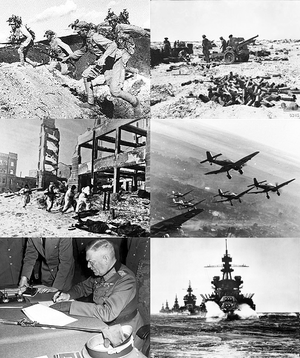World War II
World War II (often abbreviated to WWII or WW2), also known as the Second World War, was a global war that lasted from 1939 to 1945, although conflicts reflecting the ideological clash between what would become the Allied and Axis blocs began earlier. The vast majority of the world's countries—including all of the great powers—eventually formed two opposing military alliances: the Allies and the Axis. It was the most global war in history; it directly involved more than 100 million people from over 30 countries. In a state of total war, the major participants threw their entire economic, industrial, and scientific capabilities behind the war effort, blurring the distinction between civilian and military resources. World War II was the deadliest conflict in human history, marked by 50 to 85 million fatalities, most of which were civilians in the Soviet Union and China. It included massacres, the genocide of the Holocaust, strategic bombing, premeditated death from starvation and disease and the only use of nuclear weapons in war.[1][2][3][4]
The Empire of Japan aimed to dominate Asia and the Pacific and was already at war with the Republic of China in 1937,[b][5] but the world war is generally said to have begun on 1 September 1939,[6] the day of the invasion of Poland by Nazi Germany and the subsequent declarations of war on Germany by France and the United Kingdom. From late 1939 to early 1941, in a series of campaigns and treaties, Germany conquered or controlled much of continental Europe, and formed the Axis alliance with Italy and Japan. Under the Molotov–Ribbentrop Pact of August 1939, Germany and the Soviet Union partitioned and annexed territories of their European neighbours, Poland, Finland, Romania and the Baltic states. The war continued primarily between the European Axis powers and the coalition of the United Kingdom and the British Commonwealth, with campaigns including the North Africa and East Africa campaigns, the aerial Battle of Britain, the Blitz bombing campaign, and the Balkan Campaign, as well as the long-running Battle of the Atlantic. On 22 June 1941, the European Axis powers launched an invasion of the Soviet Union, opening the largest land theatre of war in history, which trapped the Axis, most crucially the German Wehrmacht, into a war of attrition. In December 1941, Japan attacked the United States and European colonies in the Pacific Ocean, and quickly conquered much of the Western Pacific. The Japanese conquests were perceived by many in Asia as liberation from Western dominance; as such, several armies from the conquered territories aided the Japanese.
The Axis advance halted in 1942 when Japan lost the critical Battle of Midway, and Germany and Italy were defeated in North Africa and then, decisively, at Stalingrad in the Soviet Union. In 1943, with a series of German defeats on the Eastern Front, the Allied invasions of Sicily and Italy which brought about Italian surrender, and Allied victories in the Pacific, the Axis lost the initiative and was forced into strategic retreat on all fronts. In 1944, the Western Allies invaded German-occupied France, while the Soviet Union regained all of its territorial losses and invaded Germany and its allies. During 1944 and 1945 the Japanese suffered major reverses in mainland Asia in South Central China and Burma, while the Allies crippled the Japanese Navy and captured key Western Pacific islands.
The war in Europe concluded with an invasion of Germany by the Western Allies and the Soviet Union, culminating in the capture of Berlin by Soviet troops, the suicide of Adolf Hitler and the subsequent German unconditional surrender on 8 May 1945. Following the Potsdam Declaration by the Allies on 26 July 1945 and the refusal of Japan to surrender under its terms, the United States dropped atomic bombs on the Japanese cities of Hiroshima and Nagasaki on 6 and 9 August respectively. With an invasion of the Japanese archipelago imminent, the possibility of additional atomic bombings and the Soviet invasion of Manchuria, Japan formally surrendered on 2 September 1945. Thus ended the war in Asia, cementing the total victory of the Allies.
World War II changed the political alignment and social structure of the world. The United Nations (UN) was established to foster international co-operation and prevent future conflicts. The victorious great powers—China, France, the Soviet Union, the United Kingdom, and the United States—became the permanent members of the United Nations Security Council.[7] The Soviet Union and the United States emerged as rival superpowers, setting the stage for the Cold War, which lasted for the next 46 years. Meanwhile, the influence of European great powers waned, while the decolonisation of Africa and Asia began. Most countries whose industries had been damaged moved towards economic recovery. Political integration, especially in Europe, emerged as an effort to end pre-war enmities and to create a common identity.[8]
Date 1 September 1939 – 2 September 1945 (6 years and 1 day)[a]
Location Europe, Pacific, Atlantic, South-East Asia, China, Middle East, Mediterranean, North Africa, Horn of Africa, Australia, briefly North and South America
Result
Allied victory
Collapse of Nazi Germany
Fall of Japanese and Italian Empires
Dissolution of the League of Nations
Creation of the United Nations
Emergence of the United States and the Soviet Union as rival superpowers
Beginning of the Cold War (more...)
Participants
Allies
Axis
Commanders and leaders
Main Allied leaders
Soviet Union Joseph Stalin
United States Franklin D. Roosevelt
United Kingdom Winston Churchill
Republic of China (1912–1949) Chiang Kai-shek
Main Axis leaders
Nazi Germany Adolf Hitler
Empire of Japan Hirohito
Kingdom of Italy Benito Mussolini
Casualties and losses
Military dead:
Over 16,000,000
Civilian dead:
Over 45,000,000
Total dead:
Over 61,000,000 (1937–45)
...further details
Military dead:
Over 8,000,000
Civilian dead:
Over 4,000,000
Total dead:
Over 12,000,000 (1937–45)
...further details
